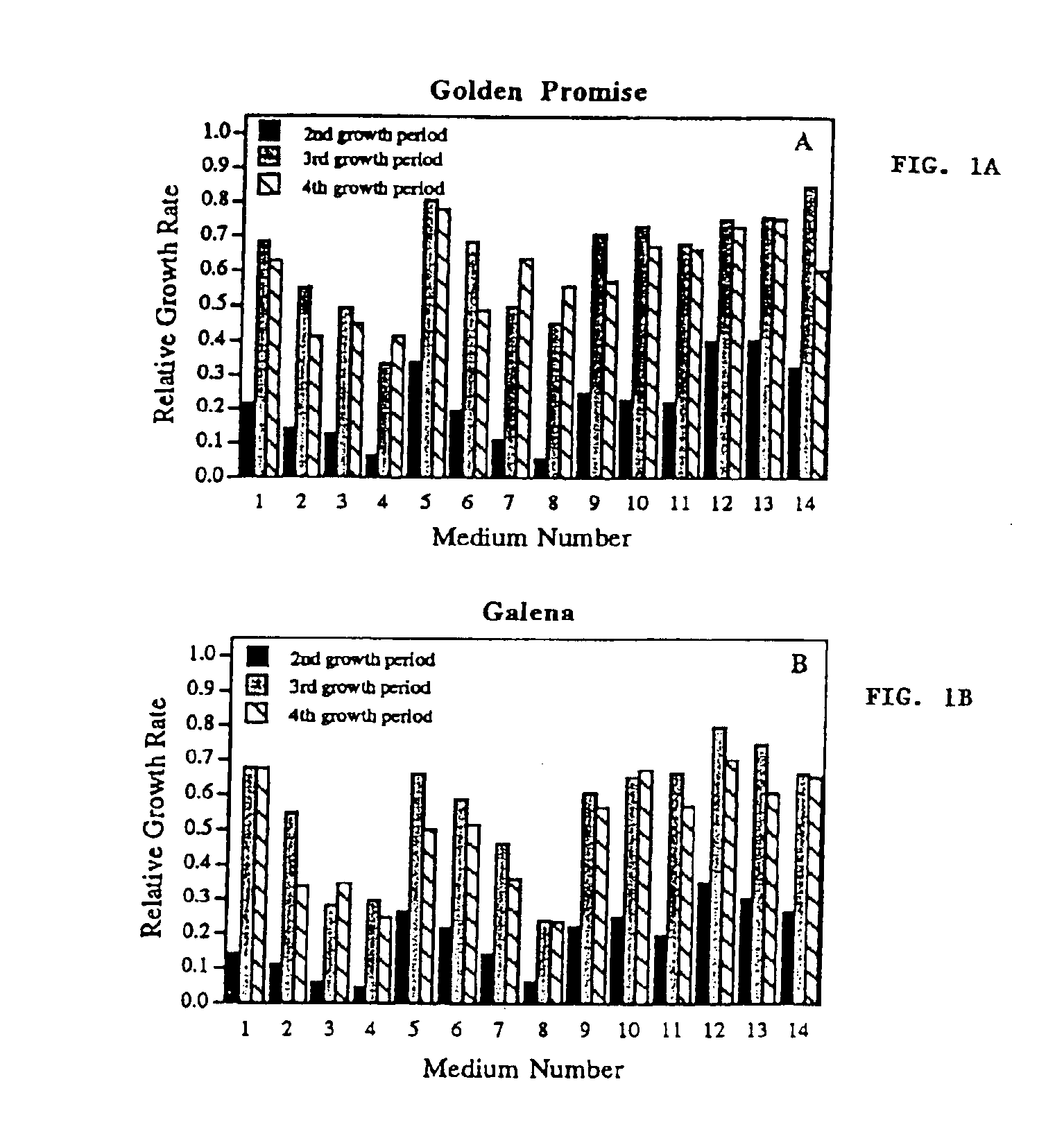Compositions and methods for plant transformation and regeneration
a technology plant growth, applied in the field of in vitro culture, plant growth regeneration, compositions and methods, can solve the problems of limited utility of available procedures for producing embryogenic callus and regenerating green plants, and sometimes hindering the gene improvement of various crop species by genetic engineering, so as to improve the regeneration ability of callus tissue, reduce the incidence of regeneration, and improve the effect of regeneration
- Summary
- Abstract
- Description
- Claims
- Application Information
AI Technical Summary
Benefits of technology
Problems solved by technology
Method used
Image
Examples
example 1
Improvement of Callus Quality and Regenerability in Barley Genotypes Golden Promise and Galena
Materials and Methods
[0070]Plant Material
[0071]Donor plants for immature embryos were grown in soil under controlled conditions in growth chambers as described (Wan and Lemaux, 1994; Lemaux et al., 1996).
[0072]As noted in other Examples below, plants were grown in a greenhouse (immature embryos grown in the growth chambers are preferred for green tissue culture). The greenhouse had supplementary lighting providing a 14-h photoperiod with temperatures of 15 to 18° C. Supplemental 1000-watt metal-halide lights were engaged when the light level in the greenhouse was less than 1000 μE / ms. Roof shades covered the roof when outside light levels rose above 7000 μE / ms.
[0073]Spring cultivars of barley (Hordeum vulgare L.) Golden Promise and Galena were used as donor plants. Galena seed was obtained from B. Treat, Coors Brewing Company, Golden, Colo. Golden Promise seed was obtained from P. Bregitzer...
example 2
High-Frequency Plant Regeneration from Transgenic and Nontransgenic Callus Tissues of Barley
Materials and Methods
[0111]Callus Induction and Maintenance
[0112]Callus induction was performed as described above using CIM with 2.5 mg / L of 2,4-D or dicamba (no cytokinin). After incubation for three weeks at 24±1° C. in the dark, callus was cut into small pieces (about 3 to 4 mm), then maintained on the same medium with subculturing at three-week intervals.
[0113]Plasmids
[0114]Plasmid ppGlbGus-6 (Liu, 1994) contains the uidA (gus) reporter gene under the control of the maize embryo-specific globulin (Glbl) promoter (containing 1.38 kb upstream of the transcription start site) and terminated by the Agrobacterium tumefaciens nopaline synthase 3′ polyadenylation signal (nos). Plasmid pdG1bGUS-6 was constructed by (1) digesting ppGlblGUS with EcoRI to obtain a 2.54-kb fragment containing 0.37-kb of the globulin promoter, uidA reporter gene and nos terminator, and (2) ligating the 2.54-kb fragme...
example 3
Reduction of Genotype Limitation and Albinism: Transformation of Barley Phenotype Golden Promise and the Recalcitrant Barley Genotype Galena
Materials and Methods
[0131]Plant Material
[0132]Donor plants for immature embryos were grown in soil under controlled conditions in growth chambers as described (Wan and Lemaux, 1994; Lemaux et al., 1996) or in the greenhouse, as noted (immature embryos grown in the growth chambers are preferred for green tissue culture, although it is not necessary to use greenhouse-grown plant material).
[0133]The greenhouse had supplementary lighting providing a 14-h photoperiod with temperatures of 15 to 18° C. Supplemental 1000-watt metal-halide lights were engaged when the light level in the greenhouse was less than 1000 μE / ms. Roof shades covered the roof when outside light levels rose above 7000 μE / ms.
[0134]Callus Induction and Green Embryogenic Tissue Production
[0135]Immature zygotic embryos about 1.5 to 2.5 mm in size were dissected and isolated intact u...
PUM
| Property | Measurement | Unit |
|---|---|---|
| concentration | aaaaa | aaaaa |
| concentration | aaaaa | aaaaa |
| concentration | aaaaa | aaaaa |
Abstract
Description
Claims
Application Information
 Login to View More
Login to View More - R&D
- Intellectual Property
- Life Sciences
- Materials
- Tech Scout
- Unparalleled Data Quality
- Higher Quality Content
- 60% Fewer Hallucinations
Browse by: Latest US Patents, China's latest patents, Technical Efficacy Thesaurus, Application Domain, Technology Topic, Popular Technical Reports.
© 2025 PatSnap. All rights reserved.Legal|Privacy policy|Modern Slavery Act Transparency Statement|Sitemap|About US| Contact US: help@patsnap.com

